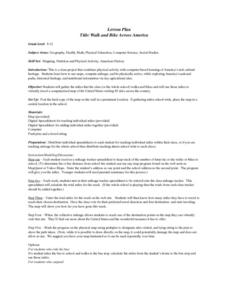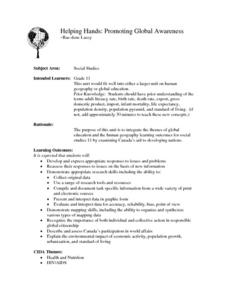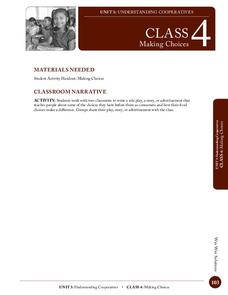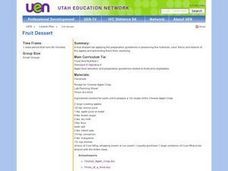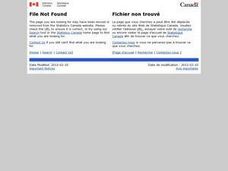Curated OER
Ground Beef Experiment
Students identify what ground beef is and the difference in fat, flavor and moistness between the three types - regular, lean, and extra lean. Then, they conduct an experiment to compare the effect of pan frying
between three different...
Curated OER
Food Patterns
In this food worksheet, students answer short answer questions about their food patterns and habits. Students complete 9 questions total.
Curated OER
THE FOODS WE EAT
Learners discuss the five food groups and the seven basic nutrients. They decorate Food We Eat booklet pages with pictures of foods found on background, rubber stamp and animation tools in KidPix. (Booklet has a page for each food group.)
Curated OER
Calories, Energy for Exercise and Life
Students calculate the number of calories they need daily and examine the impact of exercise on their caloric needs. They then determine if their daily caloric intake meets or exceeds their daily need.
Curated OER
Rice Plants
Second graders investigate what plant is closely related to to rice. In this rice farming lesson, 2nd graders dicover the parts of rice and that rice is closely related to grass. Students create a rice picture and write sentences...
Curated OER
Food Intake and Physical Activity
Fourth graders graph their estimations of caloric intake and caloric expenditures.
Curated OER
Sometimes and All the Time Foods
Students recognize a wide variety of fruit and have a greater understanding about the importance of fruit in their diet, and determine that some fruits' skins are edible and others are not.
Curated OER
Clothesline Sleuth
Sixth graders investigate the origins of clothing production. In this Social Studies lesson, 6th graders examine the components of agriculture involved in making clothes. Students research cotton.
Curated OER
Walk and Bike Across America
Students learn how to use maps, compute mileage, and be physically active while exploring America's national parks, historical heritage, and nutritional information via key agricultural sites.
Curated OER
Helping Hands: Promoting Gloval Awareness
Eleventh graders explore Canadian support for foreign aide. In groups, 11th graders discuss Canadian aide policies and express their opinion of each. Students brainstorm methods of contributing to developing nations. They complete...
Curated OER
Fiber - Adding It To The Diet - Skill Supplement
Students examine and prepare a recipe and state the purpose of each ingredient. They complete a worksheet based on the food pyramid.
Curated OER
Vermicomposting
Third graders study vermicomposting. In this vermicomposting lesson, 3rd graders prepare to begin a unit on decomposition by constructing a worm bin. Students collect worms to be used later in experiments.
Curated OER
Eat Smart. Play Hard.
Students study healthy food choices and the energy it creates for physical activity. In this food energy lesson plan, students complete multiple activities to learn about the benefits of healthy eating upon physical activity.
Curated OER
Food for Thought: Hunger???Around the Block, Around the World LESSON 2: Local Hunger and Malnutrition
Students examine the difference between hunger and malnutrition. They study the idea of hunger as a theme in literature while discovering how communities can solve hunger problems.
Curated OER
Snowball Soap
Students create their own soap sculptures and take them home to use. They gradually add water to soap flakes until they are a consistency that can be molded. They mix the concoction with their hands and then sculpt the "snow" into...
Curated OER
Stay Well Cards
Pupils draw pictures of things that help them stay healthy such as brushing teeth and washing hands. They write healthy ideas on their pictures. They post the pictures at home and in the classroom as reminders to stay healthy.
Curated OER
Ground Beef Lab - Open-Faced Tacos
Students will use ingredients and read a recipe to create open faced tacos. The emphasis of the lesson is the kind of preparation that is needed to cook ground beef correctly to avoid diseases associated with improper preparation...
Curated OER
Food Pyramid Lab
Third graders complete a lab to review the Food Guide Pyramid and prepare a food item using all of the food groups.
Curated OER
Making Choices
Students work with a partner to write a play, story or ad that teaches about our choices as consumers. Students focus on educating people about how food choices make a difference in their lives.
Curated OER
Vegetable Lecture and Experiment
Third graders experiment and answer questions to identify preparation guidelines to preserve the nutrients, enhance the color, flavor and texture of vegetables when cooking.
Curated OER
Vegetable Lab
Third graders prepare vegetables using common methods: au gratin, minimum water method, broiled, panfry, frozen, and stuffed. They share with the rest of the class and determine which methods preserve nutrients, color, flavor and texture.
Curated OER
Microwave Introduction
Sixth graders learn the principles of microwave cooking and how to use and care for it properly while preparing foods.
Curated OER
Fruit Dessert
Third graders complete a fruit lab applying the preparation guidelines in preserving the nutrients, color, flavor and texture of the apples and preventing them from oxidizing.
Curated OER
There's Omegas in Those Hemp Seeds
A very well-designed lesson plan focuses on the many benefits of Omega Fatty Acids. Learners read some articles on omega fatty acids, then access a glossary that is included in the plan. They fill in terms along with their definitions....










